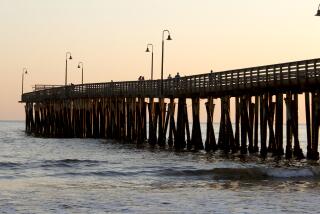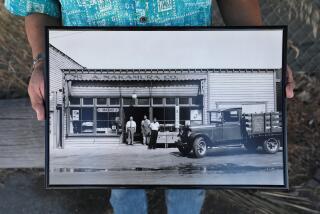Rich Niche : Newport Beach’s Tiny Harbor Island May Be the County’s Priciest Enclave
- Share via
NEWPORT BEACH — Picture the island: a part of Newport Beach that can be walked end to end in 15 minutes--less if you don’t stop to gawk--but oh so private and hard to reach. Signs on Bayside Drive direct motorists away from this little jewel, and access is via a bridge wide enough for only one car at a time.
Nearly all the houses have private docks. While there technically is public access from the water, once someone gets from the water onto the island, he’s on private property.
Some of the houses feature swimming pools or tennis courts. Most are built on lots in the 5,000- to 9,000-square-foot range.
This is tiny Harbor Island, where decades ago the lots went for $5,000--or $2,500 if you built a house on the property within a year of purchase. Now it’s the home of the $9-million tear-down, and, foot-for-foot, may be the priciest enclave in Orange County.
One family owned two lots from 1928 through 1989. Title to the property then changed hands four times in 18 months; two men who paid $6.6 million in May, 1989, sold it eight months later for around $9 million.
Those two lots used to be home to Gladys Gardiner, who was known by one friend as “the island newspaper” because of her interest in the latest goings-on. She was a gregarious woman, friendly and outgoing.
The latest owner of her property is just about the opposite, a man with such a penchant for secrecy that he bought the property through an agent in January, keeping his name off public records until July.
The new buyer? Donald Bren, president and owner of the Irvine Co. and the county’s only billionaire.
Bren, who also has homes in Holmby Hills and Linda Isle and an apartment at New York’s tony Pierre Hotel, joins Harbor Island residents like George Argyros, developer and former owner of the Seattle Mariners baseball team.
His purchase of the Gardiner property comes amid a spate of building and remodeling in this small enclave of wealth, where homes routinely sell for $5 million and up and which has only 25 or so homes, some of them on double lots, like Bren’s. For some, the recent land boom signals an end to an era on the island, a time when owners may have been nearly as rich as oil sheiks but weren’t quite as flashy about it.
For a spot that once was the summer home of violinist Jascha Heifetz and held an estate of H.F. Ahmanson, the banker whose name lives on at the Ahmanson theater in downtown Los Angeles, Harbor Island started modestly enough.
The property was dredged and filled in the 1920s, after Balboa Island and Lido Isle, and developed by Joseph Beek and Louis Briggs. Beek’s son, Allan, said three or four people lived on the island in the early days, including Gladys Gardiner and her husband, Everett, whom everyone called Duke.
Everett Gardiner “was a college chum of my father” at what is now Caltech, Beek said. “It was a typical rich-boy, poor-boy relationship. My dad was poor, working his way through school. Everett had inherited wealth, but they became strong friends.”
Gardiner, whose parents lived on Balboa Island on the property that Beek said was later bought by movie actor Buddy Ebsen, had degrees in law and engineering but never worked at either. He was, however, a tinkerer.
During World War II, Gardiner built himself a car, “a little, open, four-sided wooden thing with wheels on it and an electric motor,” remembered Jean Watt, who grew up on Harbor Island and still lives there. With gasoline tightly rationed during the war years, Gardiner used the electric car “to go over to Balboa Island and around town,” Watt said.
Linda Isle, then called Shark Island and not yet developed, was known as a fertile breeding ground for mosquitoes, Watt said. So Gardiner made a point of pouring oil on the ponds where the mosquitoes would otherwise flourish.
“Kids liked to go down and chat with Gladys,” Watt said. “We called her ‘the island newspaper.’ She was the one who knew what was going on. She was the one you could count on to know why the ambulance came on the island. And Duke was the one you could count on to fix something if it was broken. They were really the guts of the island.”
Everett “Duke” Gardiner died in 1960. Gladys continued her volunteer work with the Assistance League of Newport Beach well into her 90s. As the years went on, she grew concerned about rising property taxes on her lot and about inflation, according to those who knew her.
So in 1981, she deeded her house to Hoag Hospital, which let her live in it for the rest of her life and paid her $10,000 a month in return for inheriting the property when she died. In January of 1989, she died of heart problems, leaving an estate of $800,000--half of it going to Caltech, the rest to charities and friends--and the house.
By then, property values in Orange County were going wild.
One parcel that Beek remembers his mother selling for $300,000 or so in 1972 or thereabouts--a good chunk of change for that time--now is valued at $6.9 million by the county assessor. Another home on the island is now up for sale at about $15 million (reduced from the original asking price of more than $17 million, according to real estate agents). Properties bought in the last few years routinely show assessed values of $3 million, $5 million, $9.25 million.
One 15,000-square-foot house boasts two elevators, one at each end, to make it easier to get from the basement to the first and second floors. The owner said workmen pumped 15,000 gallons of water a minute for eight months to lower the water level on the property enough to pour the slab for the basement.
But as prices have increased, the sense of community has decreased, some old-time residents say.
“It used to be a great place,” said Larry Porter, 44, who grew up on the island but, with his siblings, sold the family property three years ago after his parents died. “But now it’s, well, like everything in general has changed. The flavor of living in Southern California now (has changed). The island is kind of a fortress for, in my opinion, people who are somewhat insensitive of the way they’ve been economically blessed.”
In bygone days, “there was an island Christmas party,” said Porter, who now lives elsewhere in Newport Beach but is thinking of moving out of the area altogether. The atmosphere year-round, he said, was one “where you waved to your neighbor, you liked your neighbor. You wouldn’t hesitate to borrow something from someone. Nowadays, they don’t even talk to each other over there.”
Jean Watt is less harsh but does say that in the old days “we had more neighborhood kinds of things going on. Now it’s kind of everyone does their own thing.”
“My father would have described it as ‘Everyone has too much money,’ ” said Watt, a longtime community activist and co-founder of the environmental group Stop Polluting Our Newport, which had notable success in putting limits on the noise from planes at John Wayne Airport.
Today’s islanders seem to be “interested in getting more money, building bigger houses and getting more cars,” said Watt. “It’s just gotten to be one of those places where, like a lot of others in Newport, they feel that every square foot has to have something built on it because it’s worth more money that way.”
Winifred Voegelin said that with all the changes on the island lately, “you kind of hunker down.” She’s lived in her house for 40 years; with her late husband, an attorney who for years was an officer in the Los Angeles Area Chamber of Commerce, she hosted an annual lawn party for the consular corps in Los Angeles, followed by a Newport Bay cruise that started and ended at the dock on their property.
Though the recent spate of building and remodeling does bother Hansel Benvenuti, a retired doctor, he finds things in general pretty fine.
The neighbors are “friendly, but keep to themselves,” he said. And the property has appreciated quite nicely.
Nearly 20 years ago, Benvenuti paid $275,000 for the lot; he figures it cost about $600,000 to build the house. Now he estimates that it’s worth about $5 million. “I couldn’t afford to buy it today,” he said. On the other hand, he figures he can’t really afford to sell it either, because of the taxes on those capital gains.
Benvenuti’s wife, Martha, a retired lawyer, said many people can look at Harbor Island without knowing just what it is they’re seeing. “They see the homes from the water, and they don’t know where they are,” she said. She especially treasures her garden and “my view of the bay every morning when I wake up.”
Though parking is a problem, requiring the Benvenutis to hire a valet parker when they have a party, she said Harbor Island remains “a private place for people who want privacy.”
Gary Hamilton, head of the island’s community association, moved there from Corona del Mar four years ago.
“I wanted to be on the water with a big yard, relatively speaking,” said Hamilton. “There are not many places on the water with yards. It’s one of the beauties of Harbor Island that everybody is restricted; they cannot build out close to the sea walls, so they have large yards, big setbacks.”
Hamilton was a co-owner of what is now the Bren property for a while, buying it from Hoag Hospital for $6.6 million with Jim Peters, another home builder.
In January of this year, Lowell C. Martindale Jr., a lawyer with the firm of O’Melveny & Myers, bought the property on behalf of Bren. Neither he nor Hamilton nor Peters will say what the price was, but county records show the property now valued at $9.25 million, so that’s the assumed selling price.
Hamilton will say that the purchase offers made to him and Peters were “so attractive” that the men scrapped their original plans to raze the Gardiner residence and build two homes for themselves on the property.
Martindale agreed that it’s “a possibility” that Bren wouldn’t buy property in his own name lest a seller see the billionaire coming and jack up the asking price. Also, he said, “Mr. Bren, for such a prominent figure, is a private person and would probably prefer to keep his personal affairs private to the extent he can.”
Martindale said Bren plans to tear down the old Gardiner residence and build a new one. That means he could eventually wind up with the highest-priced property among those on Harbor Island.
Last year, one home--a part of the old Ahmanson estate--sold at around $14 million, and it’s still under construction. And the other home on the Ahmanson property, which was divided after his death, is up for grabs at somewhere around $15 million.
More to Read
Sign up for Essential California
The most important California stories and recommendations in your inbox every morning.
You may occasionally receive promotional content from the Los Angeles Times.










